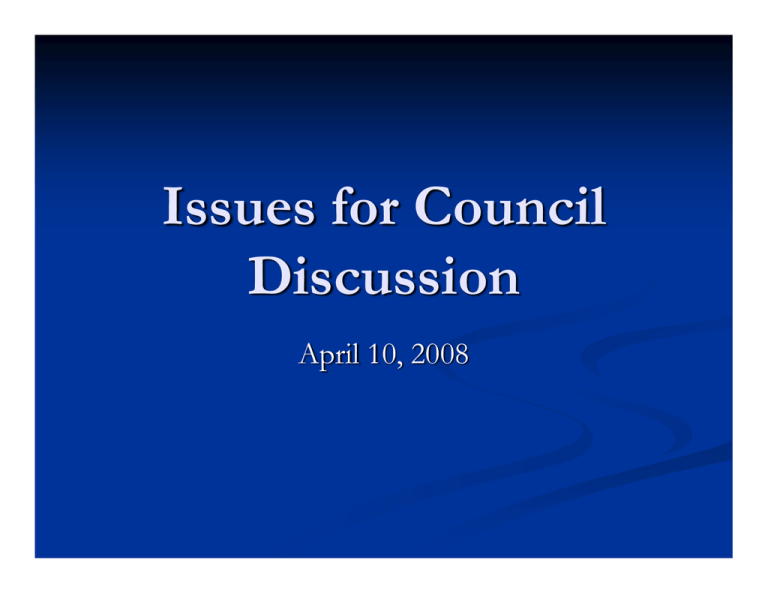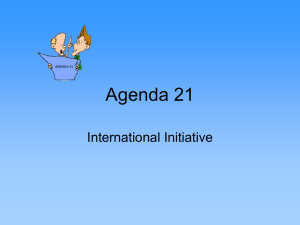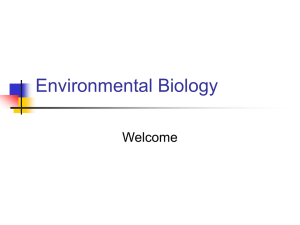Issues for Council Discussion April 10, 2008
advertisement

Issues for Council Discussion April 10, 2008 Innovative Land Preservation Tools Purpose of Report Council and others requested additional tools for land preservation (farmland and open space) that are not currently being used in New Jersey To be incorporated into Land Preservation and Stewardship Technical Report and acknowledged in RMP Land Preservation Program as potential options worthy of additional analysis and consideration No tool being recommended for immediate endorsement by Council. 1. Conservation Tax Credits An income tax credit available to landowners who voluntarily preserve their land through the donation of a conservation easement and/or fee title. The donation must protect conservation values as defined by the State and must be made to an entity qualified to hold such property interest by the terms of the legislation creating the credit. 12 states have program 2. Installment Purchase Options/Agreements (IPA) An innovative payment plan for permanent preservation, usually of agriculture, that spreads out payments so landowners receives semiannual, tax exempt interest over a term of years (typically 20 to 30), followed by principal at the end of the contract term. Burlington County, NJ and Maryland counties have IPA programs 3. Property Tax Relief In addition to the current New Jersey Farmland Assessment Program a property tax relief program would provide an even greater tax reduction to the landowner, in exchange for an equal lien payable at property sale or upon conversion of the land to an impermissible use. State pays the municipality the difference in property taxes. New York has similar program but more limited 4. Next Generation Farmland Acquisition Program (NGFAP) An innovative program where counties and commercial lenders help young or beginning farmers to purchase quality rural working land and permanently preserve this land at the same time. Credit history, equity position, work experience and proposed business plan of a beginning farmer are taken into consideration. Maryland is developing program 5. Statewide or Regional Local Land Trust/Fee Simple Creation of statewide or regional land trusts that are incorporated as non-profit tax exempt organizations under section 501(c)(3) of the Internal Revenue Service code under the purview of the State. Hold and manage conservation easements. Programs exist in Maryland and northern California 6. Term Conservation Easements A voluntary technique that preserves land for a set period of time, such as twenty or thirty years. A government or non-profit entity pays the landowner a rental fee in exchange for prohibiting non-agricultural development on the land for that period. (Can be combined with an option to purchase the land during the term.) Builds from concepts of the State Agriculture Development Committee’s 8-year conservation program 7. Land Preservation Tontine An incentive based tool, which uses a private party contract to provide incentives for landowners to maintain agricultural uses over large areas. Remaining landowners gain benefits from any landowners that sell for non-farm purposes, through claims to conversion funds. 8. Agricultural Conservation Pension An alternative way to finance a farmer’s retirement. Under the pension program retirement incremental income would be guaranteed to farmers who attach an easement to their land and continue farming the land. New concept 9. Mandatory Source Water Protection Programs for Water Purveyors A program that requires water purveyors develop and implement approved source water protection plans for their water supply sources, with an objective of achieving a specific level of protection over time. Would provide a new revenue source and implementation entity for both land preservation and the reduction of pollutant sources. Similar to New York State requirements through Department of Health Water and Wastewater Utilities Program (New for Chapter V) Purpose of the New Program Response to Public comments on Final Draft RMP suggesting a Program to provide guidance. Determine existing and potential capacity for service. Identification of appropriate or inappropriate areas for provision and how capacity would be allocated. Protective measures for resources included. Verification of Utility Capacity Update RMP data on: Permitted capacity Current and maximum demands Temporary increased or reduced demands that will revert to normal in the near term (e.g. emergencies) Contractual commitments and court-ordered commitments for future demands Estimated impacts of water conservation and efficiency methods Regulatory & Non-regulatory Constraints Identify constraints to utility capacity beyond facility capacity and current/committed demands Net water availability NJDEP Preservation Area rules at N.J.A.C. 7:38 Reservoir system safe yields Areawide Water Quality Management Plans, including sewer service areas, facility size limits, TMDLs, etc. Franchise and Contractual agreements Sensitive Environmental Resources Protect by excluding from service areas or by ordinance, unless RMP Update approved showing that resource not actually present Preservation Area (Act’s restrictions apply) Planning Area Agricultural and Forest Resource Areas, Conservation and Protection Zones, Environmentally-Constrained Sub-zones (note provisions for clusters or waivers) Highlands Open Water buffers, riparian areas, steep slopes, karst topography, prime recharge areas, Critical Habitat, parts of wellhead protection areas – as restricted under GPOs Build-out Analysis Existing Area Served – Capacity of utilities to serve full area must be analyzed: Public health & safety needs TDR receiving areas and redevelopment potential Infill & currently served properties Non-Highlands portions of service areas Planning Area ECZ Proposed Service Areas – Voluntary growth. Apply RMP density smart growth requirements Planning Area CZ and PZ Proposed Service Areas – Clusters and waivers only Clusters and Waivers Clusters – Recommending 90% minimum preservation where public or community on-site wastewater utilities used (otherwise 80% for septic systems as in Final Draft RMP). To be included in revised GPOs Public Health & Safety – Program includes approach for defining and proving need based on septic system failures or other clear public health threat, with constraints on the size of the proposed service areas Planning & Project Review Water and Wastewater Utilities planning results – part of required Utility Services Element of municipal master plan County Wastewater Management Plan can be used by reference where it includes sufficient information for any part of requirements Project Review Standards – as a result of the above analyses will be adopted by municipalities during Plan Conformance Summary of Plan Conformance Key Requirements ENVIRONMENTAL/INFRASTRUCTURE CAPACITY ANALYSES Environmental Resource Inventory RMP Update Analysis Land Use Capability Analysis “Limiting Factor” Analysis Build-Out Analysis PLANNING ANALYSES a) capacity constraints; b) natural resource protection; c) open space and farmland preservation; d) optimizing use of public infrastructure; e) transportation constraints and opportunities; f) economic sustainability; g) community needs and desires; and h) principles of equity, overall sustainability, and smart growth. Develop Land Use Plan (update or overlay) Municipal Self-Assessment As a result of the environmental/infrastructure analyses and the planning analyses municipality must complete municipal self-assessment Municipal Self-assessment Report must be prepared. List and provide schedule for all items necessary to achieve Plan Conformance MASTER PLAN Policies, Goals, Objectives Land Use Plan Housing Plan Conservation Plan Utilities Plan Circulation Plan Open Space Plan Agriculture Retention/Farmland Preservation Plan (if applicable Community Facilities Plan Sustainable Economic Development Plan Historic Preservation Plan (if applicable) Development Transfer Plan (if applicable) Relationship of Master Plan to other Plans including RMP LAND USE ORDINANCES/DEVELOPMENT REGULATIONS Definitions Zone Districts and District Regulations Application Submission Checklists Notice Requirements Highlands Council Review Resource Area and Supporting Regulations (next slide) Application Procedures Resource Area and Supporting Regulations Steep Slopes Forest Areas Open Water and Riparian Areas Ground Water Recharge Management Wellhead Protection Stormwater Management Right to Farm Critical Habitat Carbonate Rock Areas Agricultural Resources Lake Management Low Impact Development Scenic Resources Historic/Cultural REDEVELOPMENT PLANS PROPOSED MAP ADJUSTMENTS Basic Plan Conformance Plan Conformance with conditions Subset of Plan Conformance – first steps to plan conformance to be achieved within 15 months of RMP adoption for Preservation Area communities

